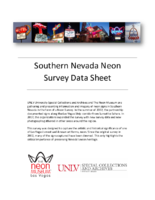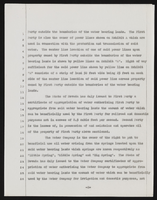Search the Special Collections and Archives Portal
Search Results
Robert E. Robinson Legislative Papers
Identifier
Abstract
The Robert E. Robinson Legislative Papers are comprised of materials relating to Robert Robinson’s career in the Nevada State Legislature as an assemblyman and senator from 1970 to 1986. The papers include correspondence, assembly bill research, bill proposals, roll calls, and materials from assembly committee meetings. The collection also contains Robinson’s campaign materials, including financial disclosures, press releases, advertisements, and correspondence with voters.
Archival Collection
Syphus-Bunker Papers
Identifier
Abstract
The Syphus-Bunker Papers date from 1891 to 1994, with the majority of the collection consisting of correspondence between Mary Etta Syphus and John Mathieson Bunker from 1891 to 1895. The collection also contains correspondence from friends and relatives, and documentation related to Mary Etta Syphus' attendance at Brigham Young Academy Church Normal Training School. Other materials include family history information and two color photographs of family homes. The collection also includes typed transcripts of the correspondence.
Archival Collection
Thomas Clark Professional Papers
Identifier
Abstract
The Thomas Clark Professional Papers (1950-1998) contain materials from his tenure as a Professor of English at the University of Nevada, Las Vegas (UNLV), which are divided into two series. The gaming research series includes newspaper clippings, correspondence, brochures, bulletins and articles. Also included are book chapters, a glossary of terms used in the casino industry, and gambling guides. In the linguistics and teaching series there are research files, articles, speeches, correspondence, interviews, multimedia, workshops, and conference materials. Also included are files on graffiti, symbolism, ethnic and regional speech differences, language usage, and National Council of Teachers of English (NCTE) material. Additional materials include colleague publications and cassette tapes of interviews from students in courses Clark taught at UNLV.
Archival Collection
K. O. Knudson Photograph Collection
Identifier
Abstract
The K. O. Knudson Photographs (approximately 1920-1969) depict the Las Vegas Grammar School and service, fraternal, and veterans organizations gathered by retired Las Vegas, Nevada school administrator and World War I veteran K. O. Knudson (also known as K. Oscar Knudson). The collection includes images of Knudson, Las Vegas Masonic Lodge members, American Legion members, and school dances. The photographs primarily feature Las Vegas, Nevada.
Archival Collection
Margo Mansergh Papers
Identifier
Abstract
The Margo Mansergh Papers (approximately 1920-2010) document the life of former showgirl and dancer Margaret "Margo" Mansergh Tomaszewski. Materials include photographs of Margo modeling, backstage at various shows, portraits, and personal family photographs as well as programs from her international career performing in the Lido de Paris and Pigalle Nightclub in London, as well as a number of shows in Las Vegas, Nevada, such as Vive Les Girls, Casino de Paris, Minsky's Burlesque, and Lido de Paris at the Stardust. The collection contains materials from Mansergh's modeling career, including photographs, book covers, and images of her as an extra in films. Digital images from the closing Stardust performance and an event for Miss Bluebell are also found in the collection.
Archival Collection
Charles P. and Delphine Squires Papers
Identifier
Abstract
The Charles P. and Delphine Squires Papers from 1882 to 1964, with bulk dates from 1905 to 1964, contain book and short story manuscripts, articles, press releases, newspaper clippings, and radio scripts written by Squires and his wife, all relating to their early life in Las Vegas. Also included are report cards, certificates, Parent Teacher Association material, Mesquite Club records and church activity materials.
Archival Collection
History of Nursing in Southern Nevada Oral History Project Records
Identifier
Abstract
The History of Nursing in Southern Nevada Oral History Project Records (1965-2014) are comprised of material related to a volunteer project initiative at the University of Nevada, Las Vegas School of Nursing to conduct oral history interviews with nurses who have practiced in Southern Nevada. The collection contains subject files related to the project, as well as audio, video, and transcript files for the interviews. The collection also includes general information on nursing in Southern Nevada such as research papers and documents from the Nevada Nurses Association.
Archival Collection
Nevada Test Site Oral History Project Records
Identifier
Abstract
The Nevada Test Site Oral History Project Records (approximately 1950-2008) consist of oral histories collected by University of Nevada, Las Vegas Department of History for the Nevada Test Site Oral History Project. The collection includes digital audio recordings of interviews, print and digital transcripts, and a small selection of digital video recordings. Some interviews have also been supplemented with photographs, letters, scientific articles, brochures, news clippings and ephemera about the Nevada Test Site.
Archival Collection

Inspire Theater Neon Survey document, August 18, 2017
Date
Archival Collection
Description
Site address: 107 S Las Vegas Blvd
Sign owner: Fremont LV Blvd LLC
Sign details: The original construction year of the building dates back to 1952. Though in 2013 the building was redesigned to open as the Inspire theater in 2014. The Inspire Theater offers a variety of venues including a 150 seated theater, a rooftop patio and multiple cocktail bars.
Sign condition: 5 - new sign with good quality day and night
Sign form: Blade and semi-decorated shed
Sign-specific description: The sign itself is all connected though it wraps around the whole building, it starts with a long rectangular blade with their logo then goes in a rectangle around the building and ends with their logo on a shorter blade with their logo. The longer white rectangular blade portion begins on the corner of the building above their rooftop lounge (which meets together back to back with a smaller rectangular blade). If you are going north on Las Vegas Blvd you will see the big blade which reads "INSPIRE" in channeled silver thin print font letters. The adjacent blade is a bit shorter, so you can see a portion of the big blade over the smaller one if you are looking at the building from the East Fremont District, with this overlay it looks like there is a letter "I" and a dash(-) underneath it. On the actual portion of the shorter blade there are the "INSPIRE" thin channeled font letters, which are identical in design to the other side of the sign but just a smaller font. The outside edges of these back-back signs are horizontally lined with neon tubing. These blades then continue around the building into two horizontally neon lined strips that make the building have a decorated shed feature to it. This then makes a rectangular feature around the whole building. In between the top of the rectangle and the bottom, there is a balcony where guests can hang out. Though on both the left and the right sides of the blade there are plasma screens that show advertisements for their property. Also on the west side of the building there are thin horizontal strips of LED/plasma lights that sparkle in an iridescent fashion.
Sign - type of display: Neon
Sign - media: Steel
Sign - non-neon treatments: T.V. screens, LED
Sign animation: Flasher and iridescent light flow
Sign environment: On the corner of South Las Vegas Blvd. and Fremont St. East, the first property on the south side of the Fremont St East District.
Sign - date of installation: 2014
Sign - thematic influences: The sign is incorporated into the architecture, as well as the sign wraps around the entire building which is remnant of the decorated shed look. The sign is related to the theater theme since the blade style sign was very prominent for the 1950's and 60's movie theater signs, such as the El Portal movie theater sign.
Sign - artistic significance: Their sign is very remnant of a 1950's Movie theater sign with the blade and wrap around of Neon, since they are a modern day theater it seems as if it's a retro throwback.
Survey - research locations: Inspire website, assessor's website
Surveyor: Emily Fellmer
Survey - date completed: 2017-08-18
Sign keywords: Blade; Neon; Steel; LED; Flashing; Video screen
Text

